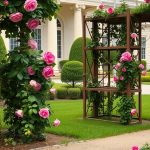Mailbox plants can add a unique touch to your outdoor space, bringing color and life right to your doorstep. These hardy plants are perfect for individuals who love gardening but may not have a lot of space or time to commit to traditional flowerbeds. From surefire blooms to low-maintenance varieties, here are 19 fantastic options that will make your mailbox area pop without demanding too much of your attention.
Hostas: Lush Foliage for Shady Areas

Hostas are a fantastic choice for adding greenery to shady spots in your garden. Their broad leaves create a lush look that can really brighten up darker areas.
In the image, you can see a striking mailbox surrounded by healthy hostas. The vivid green leaves complement the elegant mailbox, making a charming scene. This combination not only serves a practical purpose but also adds a touch of beauty to your outdoor space.
These plants thrive in partial to full shade, making them perfect for those tricky spots under trees or near structures. With a variety of leaf colors and sizes, hostas can fit into any garden design.
Lavender: Fragrant and Low Maintenance

Lavender is a charming addition to any mailbox garden. It brings a delightful fragrance that many people adore.
In the image, we see a rustic mailbox surrounded by lush lavender blooms. The vibrant purple flowers create a stunning backdrop, adding a pop of color and beauty to the area.
This plant is not only lovely to look at, but it’s also easy to care for. Lavender thrives in sunny spots and requires minimal watering, making it perfect for busy gardeners.
Moreover, lavender attracts beneficial pollinators like bees and butterflies. So, by planting it near your mailbox, you not only boost curb appeal but also support local wildlife.
Consider incorporating lavender into your mailbox garden. It’s a simple way to enjoy a fragrant, low-maintenance plant that brings joy throughout the growing season.
Coneflowers: Attracting Pollinators
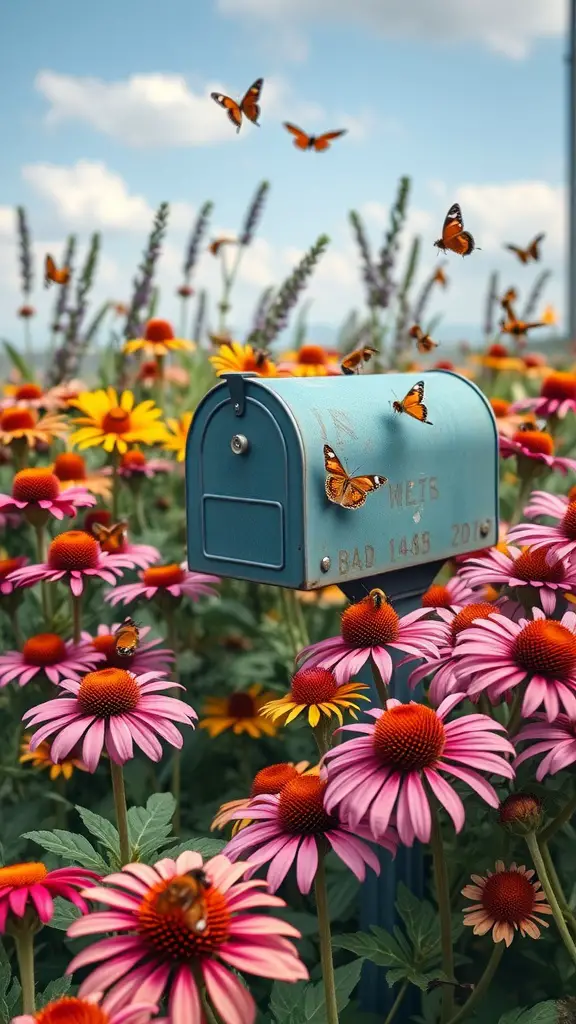
Coneflowers, with their bright and cheerful blooms, are a favorite among gardeners and pollinators alike. In the image, you can see a vibrant display of coneflowers alongside a charming blue mailbox. The coneflowers, particularly the pink varieties, attract butterflies and bees, creating a lively scene filled with fluttering activity.
The sight of butterflies dancing around the flowers is not just beautiful; it’s essential for our ecosystem. These pollinators help in the reproduction of the plants, ensuring a continuous cycle of growth and blooming. Each flower acts as a source of nectar, drawing in various species of butterflies and bees, which are crucial for pollination.
The colors of the flowers, especially the bright pink and orange shades, stand out beautifully against the blue mailbox and the clear sky. This creates a picturesque view that many would love to have right in their backyard, blending functionality with natural beauty.
Planting coneflowers is easy and rewarding. They thrive in full sun and are fairly low-maintenance, making them perfect for gardeners of all levels. By including these flowers in your garden, you not only beautify your space but also contribute to the health of local pollinator populations.
Daylilies: Vibrant Colors and Easy Care
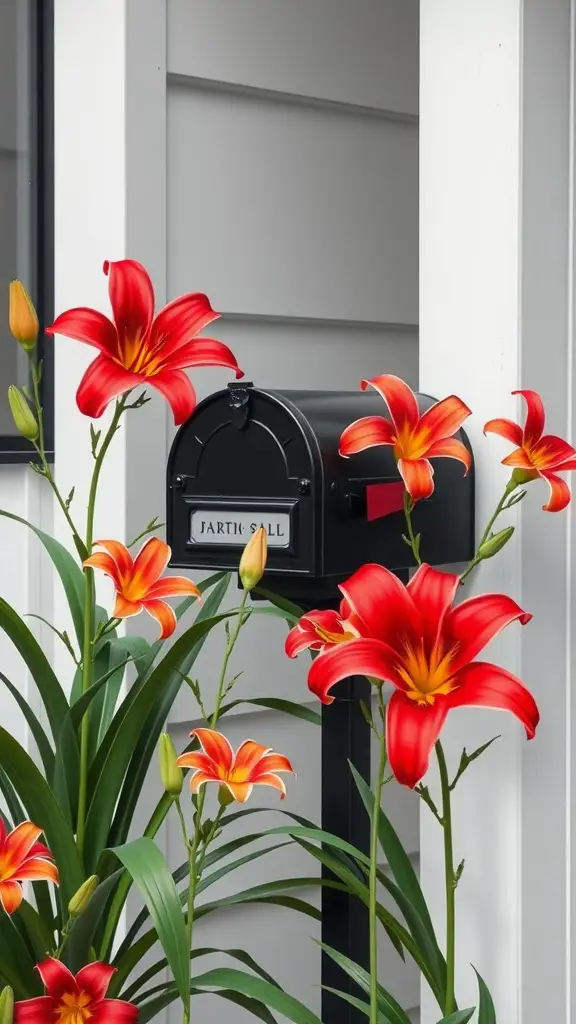
Daylilies are a fantastic choice for mailbox plants, bringing a burst of color right to your front door. In the image, you can see striking red and orange blooms that brighten up the area surrounding a classic black mailbox. These flowers are not just pretty; they are also easy to take care of.
These plants thrive in various conditions and require minimal maintenance. Daylilies can handle drought and poor soil, making them a great option for busy gardeners or anyone looking to add some flair without a lot of effort. Just a little sunlight and occasional watering will keep those vibrant colors shining.
The combination of daylilies and a mailbox creates a warm welcome for visitors. With their cheerful appearance, they invite a sense of home and charm. So, whether you’re planting for yourself or to impress guests, daylilies are a go-to choice that won’t disappoint!
Hellebores: The Winter Bloomers
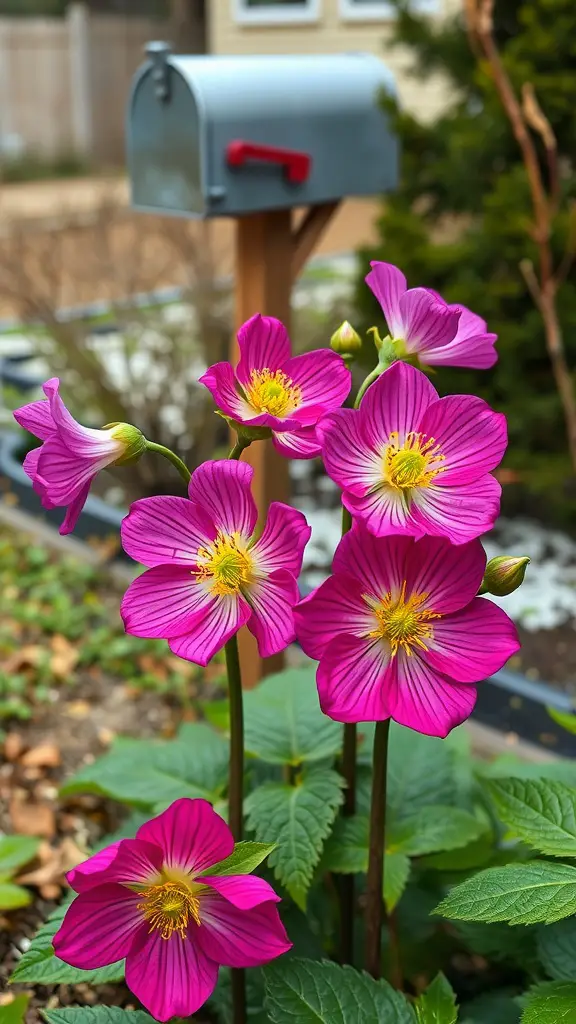
Hellebores are a fantastic choice for adding color during the colder months. These blooms are known for their resilience, often flowering even when snow is still on the ground.
The image shows beautiful pink hellebores standing tall next to a mailbox. Their vibrant petals bring life to a winter landscape, creating a cheerful focal point. The contrast between the bright flowers and the grey mailbox adds to the charm of this scene.
These flowers come in various colors, making them versatile for any garden. They thrive in shady spots, which makes them perfect for planting under trees or near structures. With proper care, hellebores can provide stunning blooms for years.
Rudbeckia: Bright and Cheerful Blooms

Rudbeckia, often known as black-eyed Susans, brings a splash of sunshine to any garden. This image perfectly captures their vibrant yellow petals surrounding a classic black mailbox. Their cheerful blooms seem to welcome everyone that passes by.
The bright yellow flowers contrast beautifully with the mailbox, adding a lively touch to the scene. The green leaves provide a lush backdrop, making the colors pop even more. It’s the kind of view that instantly lifts your spirits.
These flowers are not only pretty but also hardy. They thrive in various conditions, making them a favorite for gardeners looking for low-maintenance plants. Whether in full sun or partial shade, Rudbeckia adapts well.
With their long blooming season, these beauties provide color from summer into fall. They attract butterflies and bees, contributing to a vibrant garden ecosystem. Incorporating Rudbeckia plants around your mailbox not only enhances curb appeal but also invites nature to your doorstep.
Sedum: Hardy Succulents for All Seasons

In this vibrant garden, you can see an eye-catching arrangement of sedum plants. These hardy succulents bring a splash of color to any space. Their unique shapes and shades, ranging from deep reds to bright greens, create a lively atmosphere.
The mailbox stands tall among the sedum, adding a charming touch to the scene. This setup shows how you can incorporate plants into your landscaping, making even the mailbox area a focal point. Sedum is easy to care for, thriving in different conditions and providing beauty year-round.
If you’re looking to add low-maintenance plants to your garden, sedum is a fantastic choice. They require minimal water and can survive in various climates, making them perfect for busy gardeners. Plus, their ability to spread and fill in spaces makes them ideal for creating a lush look around your mailbox.
Boxwood: Classic Greenery for Structure
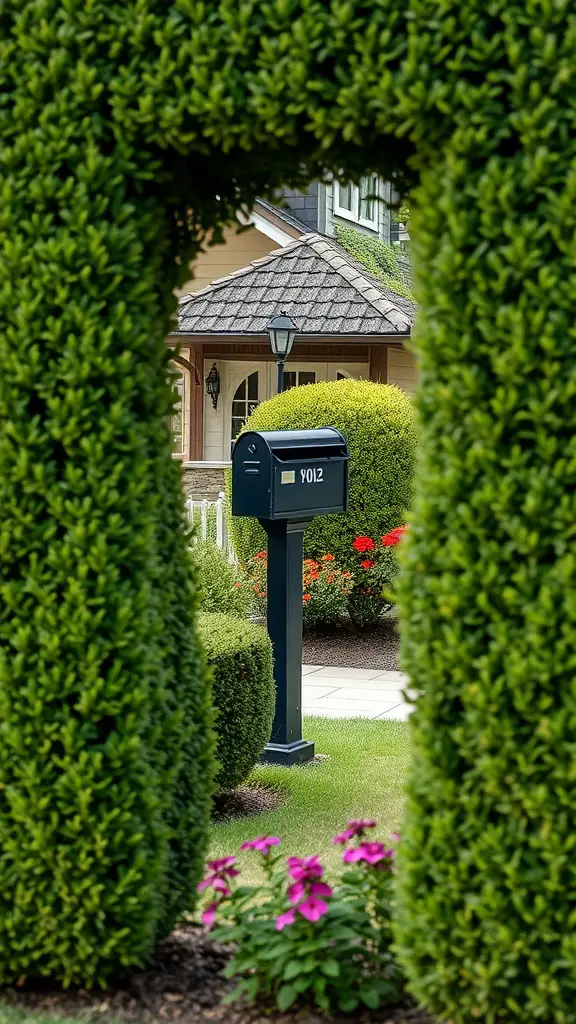
Boxwood is a fantastic choice for creating a classic look in your garden. The dense, green foliage forms a natural frame, making your mailbox stand out beautifully. In the image, note how the boxwoods are trimmed into neat shapes. This gives a tidy appearance that enhances the overall landscape.
Boxwoods are not just about looks; they are sturdy plants that can withstand different weather conditions. They maintain their vibrant green color all year, making them a reliable option for adding structure to your yard. The mailbox, sitting snugly between the lush greenery, highlights a charming and inviting entrance.
Surrounding the mailbox, the colorful flowers provide a lovely contrast to the boxwood’s deep green. Combining these elements brings life to your space and creates a welcoming atmosphere for guests. Overall, boxwoods are a smart choice for anyone looking to add a touch of elegance and structure to their mailbox area.
Butterfly Bush: A Magnet for Butterflies
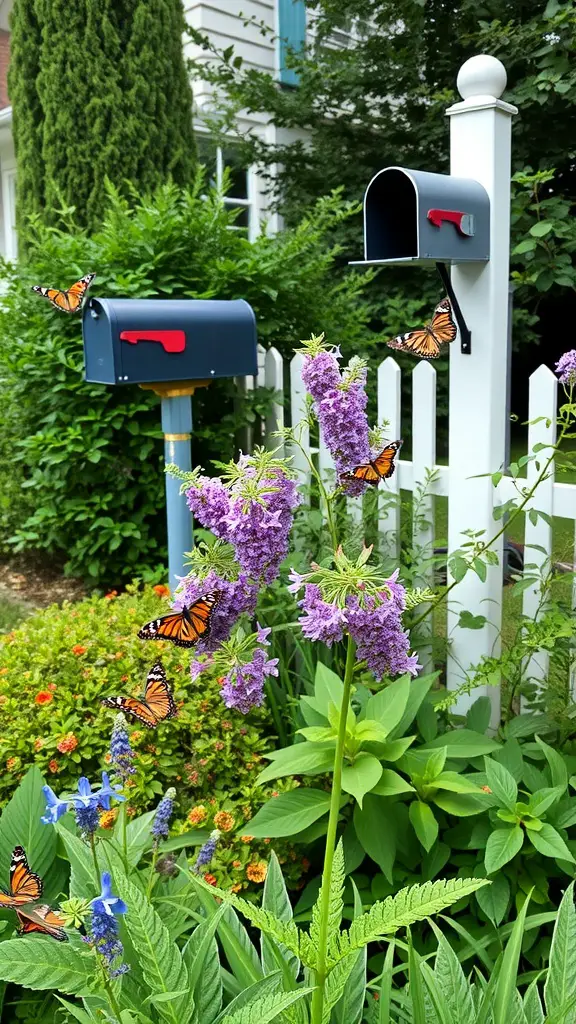
The Butterfly Bush is a delightful addition to any garden, especially for those who love nature. In this image, you can see stunning purple blooms attracting several butterflies, creating a lively scene. The bright orange Monarchs flutter around, showcasing their beauty against the flowers.
These bushes are known for their sweet fragrance and vibrant colors. They can grow quite tall, making them a perfect backdrop for your mailbox or garden area. The way they draw in butterflies makes them a favorite among gardeners.
Having a Butterfly Bush near your mailbox not only enhances your garden’s look but also brings joy as you watch butterflies come and go. It’s a lovely reminder of the beauty of nature right at your doorstep.
Marigolds: Bright Annuals with Benefits
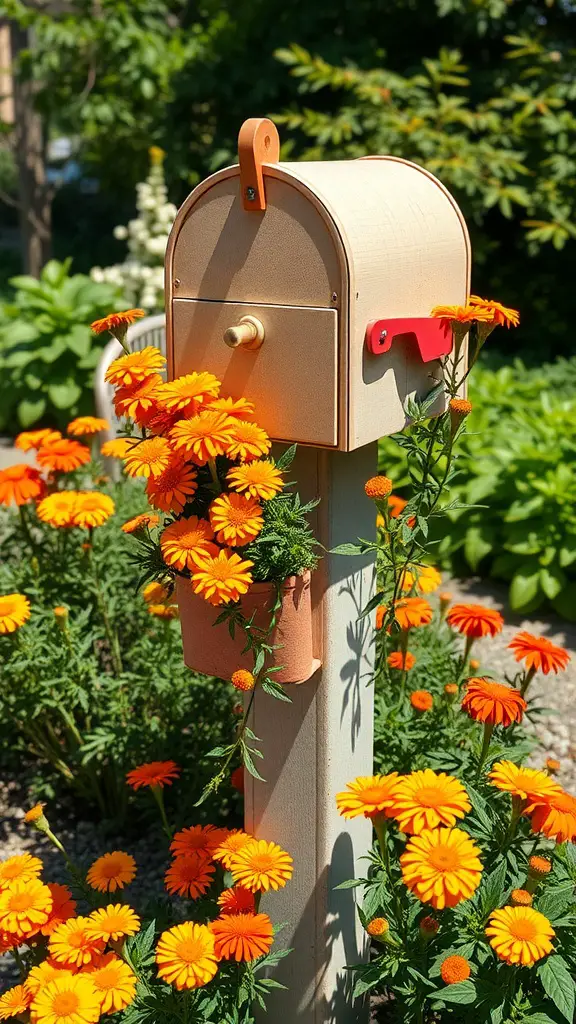
Marigolds are one of the most cheerful additions to any garden, and this image captures their bright charm perfectly. The vibrant orange blooms surround a quaint mailbox, creating a lovely scene that makes anyone smile.
These annuals are not just pretty to look at; they also offer several benefits. Marigolds are known for their ability to deter pests, making them a great companion plant in any garden. Their strong scent can keep unwanted insects at bay, which helps protect other plants nearby.
The striking colors of marigolds can brighten up any space, whether in a garden or as part of a decorative arrangement. The way they cascade around the mailbox in the image adds a whimsical touch, making mail delivery a little more delightful.
Planting marigolds is simple, too. They thrive in sunny spots and appreciate well-drained soil. With a little water and care, they can bloom from spring until frost, giving you a long-lasting display of color.
Creeping Thyme: A Ground Cover Delight
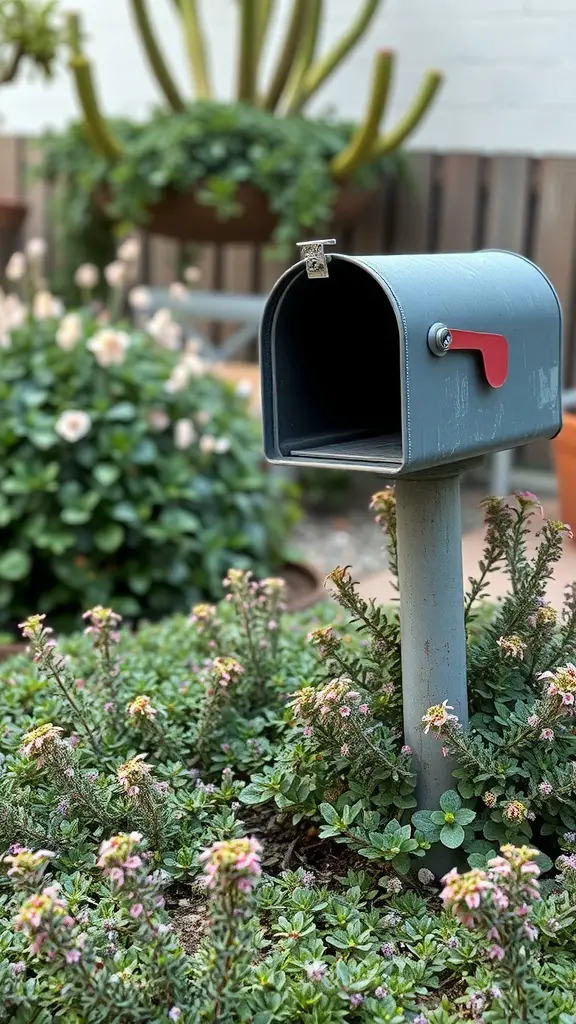
Creeping thyme is a charming ground cover that pairs beautifully with elements like mailboxes. The image shows a mailbox standing proudly amidst lush creeping thyme, its tiny pink flowers adding a touch of color. This hardy plant thrives in sunny spots and can handle foot traffic, making it perfect for garden paths or around mailboxes.
Creeping thyme not only looks delightful but also releases a lovely fragrance when walked on. Imagine picking up your mail while enjoying the refreshing scent wafting up. It’s a fantastic choice for anyone looking to add some character to their yard.
This plant is low-maintenance, requiring little water once established. Just a sprinkle here and there, and you’ll have a vibrant ground cover year-round. It’s perfect for those who want a beautiful garden without the fuss!
Astilbe: Feathery Flowers for Moist Areas
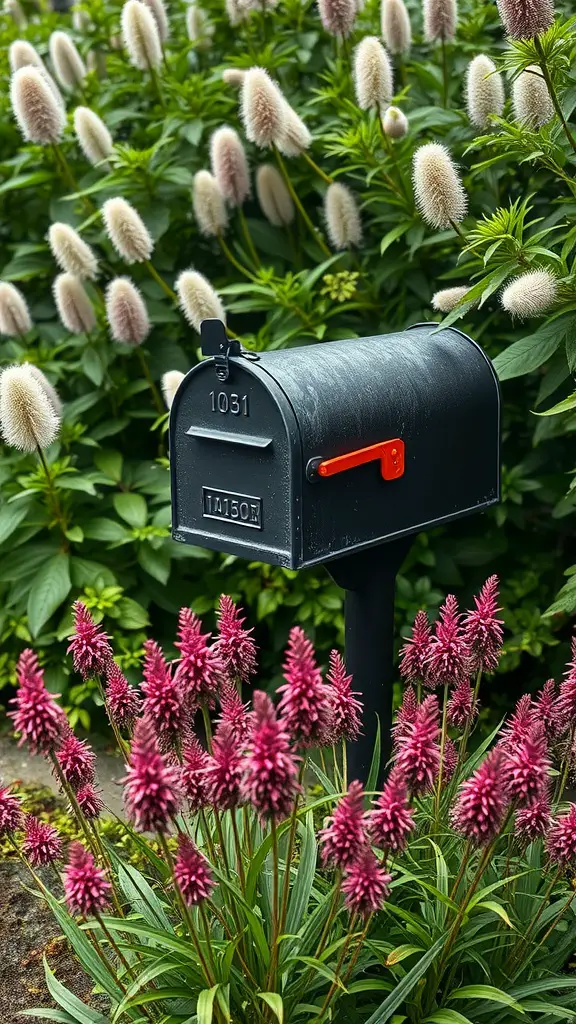
Astilbe is a stunning plant that showcases feathery flowers, making it a delightful choice for moist areas in your garden. In the image, a black mailbox stands in front of lush Astilbe plants, which bloom in vibrant colors. The tall, fluffy flower spikes add a unique texture to the scene.
This plant thrives in shaded and damp spots, perfect for gardens that may not receive a lot of direct sunlight. The soft pink and purple hues of the Astilbe create a beautiful contrast against the dark mailbox, drawing the eye and adding charm to the landscape.
When planted in groups, Astilbe can create a lovely, flowing look. Their blooms attract pollinators, making them beneficial for local wildlife. If you’re looking for a way to enhance your garden with low-maintenance yet eye-catching flowers, Astilbe is a fantastic choice.
Japanese Maple: Stunning Foliage Contrast

The Japanese Maple is a standout choice for anyone wanting to add some flair to their mailbox area. The bright red leaves create a striking contrast against the black mailbox, making it an eye-catching feature of the landscape.
This tree is known for its delicate, finely cut leaves that change colors with the seasons. In spring and summer, the vibrant red or green hues are a treat for the eyes, while fall brings an explosion of color that can brighten any day.
Not only does the Japanese Maple enhance your curb appeal, but it also offers a sense of serenity. Its graceful branches and unique leaf shapes invite a moment of pause for anyone passing by.
Phlox: Colorful Blooms from Spring to Fall
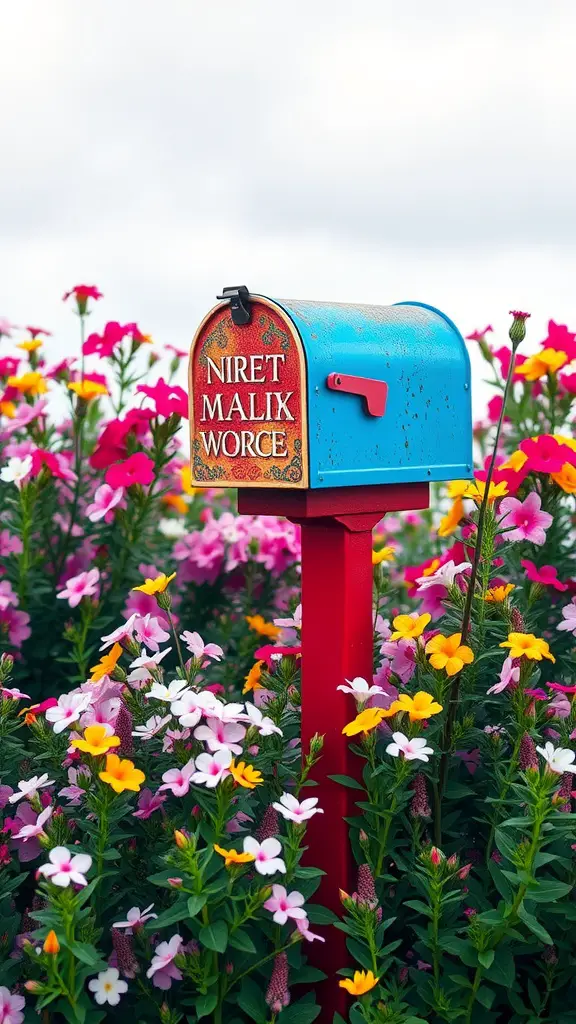
Phlox is a delightful plant that brings vibrant colors to gardens and mailboxes alike. In the image, a bright blue mailbox stands proudly amidst a sea of colorful phlox flowers. Their pinks, whites, and yellows pop against the rich green foliage, creating a charming scene that feels welcoming and cheerful.
These flowers bloom from spring all the way through fall, offering a long-lasting display of color. The cheerful hues of phlox not only enhance the beauty of any garden but also make a perfect backdrop for a mailbox. Just imagine checking your mail surrounded by such lively blooms!
Phlox is easy to care for, making it a favorite among gardeners. With the right light and soil, they thrive and keep your mailbox looking inviting. So, if you’re looking to add a splash of color to your outdoor space, consider planting some phlox!
Ferns: Lush Greenery for Texture
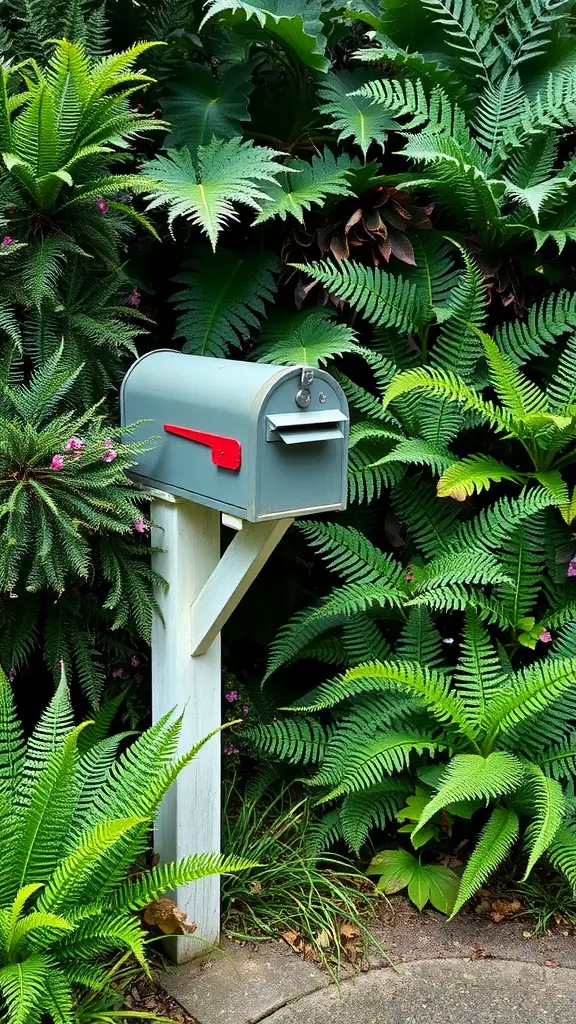
Ferns bring a vibrant touch to any space, and this image captures that perfectly. The mailbox, with its muted color and simple design, stands out against a backdrop of lush ferns. These plants create a rich texture, adding depth and life to the scene.
The various shades of green in the ferns create a beautiful contrast with the mailbox. Their intricate fronds and soft edges soften the look of the mailbox, making it feel more inviting. Foliage like this can transform an ordinary spot into a cheerful corner filled with nature.
This visual shows how ferns can be a fantastic choice for landscaping. They thrive in many environments and can enhance the beauty of any outdoor area. Adding a few ferns around your mailbox or garden can make it feel more connected to the natural world.



